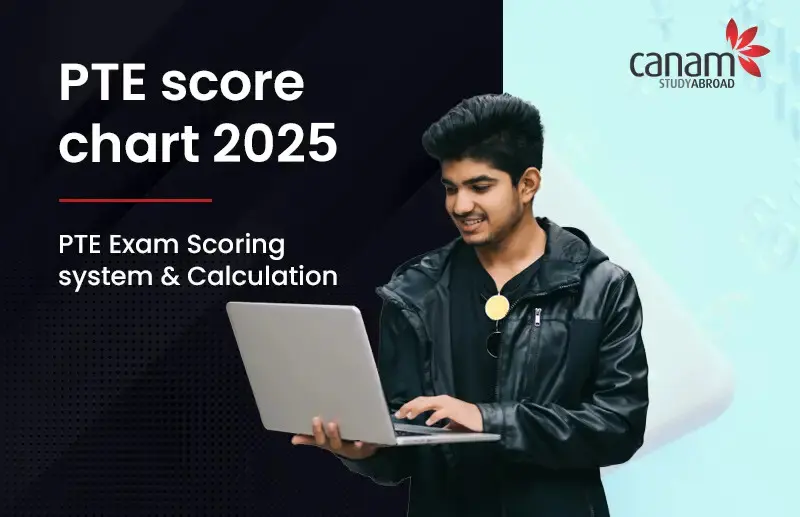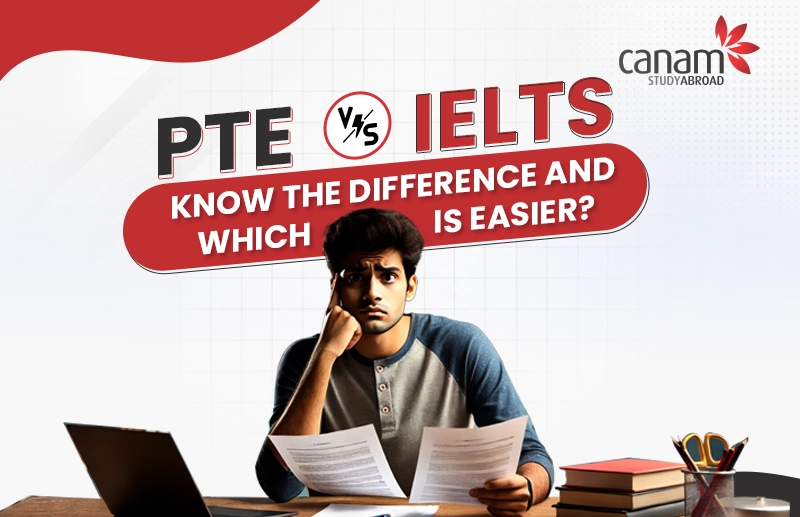IELTS Exam Pattern 2025 - Explore Section-wise IELTS Exam Format, Marking Scheme & Duration
Table of Contents
IELTS Exam Pattern
To understand the IELTS exam pattern, a candidate should first understand the IELTS Syllabus. The IELTS syllabus has different sections that covers Reading, Writing, Listening and Speaking modules.
What are the Different Types of IELTS?
IELTS Academic & IELTS General training are the two major IELTS exam types.
On the other hand, Students who want to enrol in a university for undergraduate or graduate study need to take the IELTS Academic Test. Most universities in the United States, the United Kingdom, Australia, Ireland, Canada, and New Zealand accept this test and set a minimum IELTS score that applicants must meet to be considered for admission. This exam aims to determine if you possess the essential English language abilities to function in a setting where the predominant language of instruction is English. Therefore, it should go without saying that to succeed in a higher education setting, you will require a better level of English proficiency, which implies a high IELTS score.
People who want to relocate overseas, land a job with a company in an English-speaking nation, or brush up on their English language abilities typically opt for the IELTS General Training Test.
Your speaking, reading, writing and listening skills are evaluated on both IELTS exams. While the Reading and Writing sections are different for each test, the Listening and Speaking sections are the same.
IELTS Exam Formats
Paper-delivered Format and Computer-delivered Format : Administered through a paper-delivery method for over 30 years, the IELTS test is now conducted through a computer since August 2018. It is crucial to remember that the IELTS computer-delivered format follows the same question structure, format, difficulty level, and scoring as the paper-based version. The only difference is that you use a computer to administer the listening, reading, and writing tests.
Students will take the first three parts of the test on the same day in the order of Listening, Reading and Writing without any breaks between these tests. The Speaking test will be scheduled on the same day or within seven days before or after, depending on local arrangements.
IELTS Life Skills Format: Anyone looking to prove their English speaking and listening skills to receive a UK Visa must take the IELTS Life Skills test.
The test is designed to meet the requirements of UKVI for certain visa categories and other immigration requirements. Candidates can take the test with another test taker and an examiner. The candidate’s performance in Speaking and Listening is evaluated during one session with no breaks between the speaking and listening components.
They will be assessed on their everyday communication in an English-speaking country through a variety of topics, such as:
- Personal experiences
- Family & friends
- Purchasing everyday essentials
- Education, work or training
- Weather, and leisure
- Transport, housing, or health
And many more.
IELTS for UKVI Format : Anyone from a non-English speaking country planning to study, work or move to the UK must take an IELTS test approved for UK Visa and Immigration (UKVI). IELTS for UKVI follows the same format or level of difficulty and scoring as the IELTS (paper or computer-based). It follows certain extra security protocols to ensure the authenticity of the test taker. The TRF (Test Report Form) differs slightly from the TRF received in regular IELTS.
IELTS Paper Pattern
| Section | Duration | IELTS (General or Academic) | No. of Questions Per Section |
| Listening | 30 Minutes | It includes four recorded monologues and conversations | 4 Sections - 10 Questions Each |
| Reading | 60 Minutes | Three long reading passages with tasks. Texts can range from descriptive and factual to discursive and analytical, which include non-verbal material like diagrams, graphs, and illustrated texts (taken from books, journals, and newspapers) |
40 |
| Writing | 60 Minutes (20 minutes for Task 1) (40 minutes for Task 2) | A writing task of at least 150 words where the candidate must summarize, describe or explain a table, graph, chart or diagram, and another short essay task of at least 250 words | 2 |
| Speaking | 11 to 14 Minutes | The face-to-face interview includes short questions, where you will have to speak at length about a familiar topic and have a structured discussion. | 3 |
Life Skills IELTS Paper Pattern
When preparing for the Life Skills IELTS, students must remember that there are three levels to the test.
a.) IELTS Life Skills – A1 Speaking and Listening
b.) IELTS Life Skills – A2 Speaking and Listening
c.) IELTS Life Skills – B1 Speaking and Listening
Life Skills CEFR Level A1
The Life Skills Level A1 test takes 16-18 minutes.
Test takers must listen actively and respond to spoken language, including simple narratives, statements, questions and single-step instructions.
They should be proficient in communicating basic information, feelings and opinions on familiar topics.
Candidates must also be able to converse with another person in familiar situations, discussing various topics.
Life Skills CEFR Level A2
When taking the Life Skills Level A2 test, test takers will be allowed 18 to 20 minutes. They are expected to listen and respond to spoken language, including straightforward information, short narratives, explanations and instructions.
They must effectively communicate information, express feelings and share opinions on familiar topics.
They should be able to converse with one or more people in familiar situations to establish an understanding of familiar topics.
Life Skills CEFR Level B1
In 22 minutes, candidates must demonstrate the ability to listen and respond to spoken language with simple information and narratives while understanding specific explanations and instructions.
They should be able to communicate a set of information to express their feelings and opinions on a wide range of familiar topics with appropriate formality.
Candidates should be able to converse with one or more people by making relevant points and responding to others with a shared understanding of various topics.
Paper Pattern for IELTS UKVI
The IELTS UKVI (United Kingdom Visa and Immigration) Test follows the same pattern as the regular IELTS test. It will have Listening (Approximately 30 minutes), Reading (60 minutes), Writing (60 minutes), and Speaking Sections (11 to 14 minutes). Each section is scored on a band scale from 0 to 9.
IELTS Test Pattern
Candidates must compose their responses to the list of questions after listening to four recordings of fluent English speakers.
IELTS Test Format-Listening
- Recording 1 - A conversation between two persons in any typical social setting is captured in Recording 1.
- Recording 2 - It is a monologue situated in a typical social setting.
- Recording 3 - A conversation between up to four persons recorded in the context of instruction or training.
- Recording 4 - A monologue on any academic topic is recorded in take four.
IELTS Test Format – Reading
There are 40 questions in the Reading section of the exam, all of which are designed to evaluate various reading abilities. These include reading for primary concepts, reading for details, and comprehending logical reasoning. The reading module consists of three long passages covering a wide range of topics, from argumentative to descriptive to factual. The materials are chosen for university applicants from periodicals, journals, newspapers, and books.
IELTS Test Format – Writing
The topics covered in the Writing component of the exam are appropriate for undergraduate and graduate students applying to universities. The test taker has 60 minutes to do both assignments. The first task takes 20 minutes, while the second takes 40 minutes.
Task 1 - A candidate must write a summary of at least 150 words of a table, graph, or procedure in Task 1 of the IELTS Academic Module. A candidate must compose a letter of at least 150 words for Task 1 of the IELTS General Training Module.
Task 2 - The Academic and General Training Modules Task 2 asks you to write an essay of at least 250 words. Candidates will be required to respond to an issue, argument, or point of view in an essay. Ensure that you formally respond to the task.
IELTS Test Format – Speaking
The candidate's spoken English is observed during the speaking portion, and each test is documented.
Part 1: The test-taker will be asked open-ended questions about themselves and common subjects like work, school, and/or home. The first segment lasts four to five minutes.
Part 2: A cue card with a question regarding a specific subject will be provided to the exam taker. You will have a minute to prepare before you speak for two minutes, and the examiner will then ask a question or two about the chosen subject.
Part 3: Questions about the subject the test-taker spoke in Part 2 will be asked. You will get to talk more in-depth about the concepts and problems here. This section lasts for four to five minutes.
Date and Frequency
IELTS test dates are offered upto 4 times in a month making a total of 48 fixed dates in one calendar year. The availability of IELTS dates in India may vary for Academic and General IELTS.
Center and Admit Card
The IELTS Exam is offered at more than 50 locations across India. No admit card is provided for the IELTS examination.
Result
IELTS Exam results are released 10 calendar days after the paper-based exam and 5-7 calendar days for the computer based test. The candidate will receive only ONE original Test Report form (TRF).
Score Reporting
A candidate may request to have upto 5 additional TRFs sent to the receiving institutions (universities, professional bodies, etc) within 1 month of taking the IELTS test. TRFs sent by courier will be sent via DHL and students will be charged accordingly. If the receiving institution accepts electronic submission of scores then that can be arranged through the IDP IELTS office free of charge.
Score Validity
2 Years
Free IELTS Mock Tests
Predicting the answer
12.1k Users
Barron's T-6
12.1k Users
Barron's T-5
12.1k Users
Barron's T-4
12.1k Users
Barron's T-3
12.1k Users
Official Cambridge Test 8
12.1k Users
Peter May 1
12.1k Users
Peter May 2
12.1k Users
Barron's T-2
12.1k Users
Barron's T-1
12.1k Users
Peter May 4
12.1k Users
Peter May 3
12.1k Users
Identifying main ideas
12.1k Users
Recognising paraphrase
12.1k Users
Selecting from a list
12.1k Users
Understanding categories
12.1k Users
Describe a place
12.1k Users
Following a conversation
12.1k Users
Recognising text types
12.1k Users
Barron's T-6
12.1k Users
Barron's 4th Edi. AT-1
12.1k Users
Barron's 4th Edi. AT-2
12.1k Users
Barron's 4th Edi. AT-3
12.1k Users
Barron's 4th Edi. AT-4
12.1k Users
Practice Plus T-1
12.1k Users
Practice Plus T-2
12.1k Users
Practice Plus T-3
12.1k Users
Practice Plus T-4
12.1k Users
Practice Plus T-5
12.1k Users
Practice Plus 2 AT-1
12.1k Users
Practice Plus 2 AT-2
12.1k Users
Practice Plus 2 AT-3
12.1k Users
Practice Plus 2 AT-4
12.1k Users
Practice Plus 2 AT-5
12.1k Users
Practice Plus 2 AT-6
12.1k Users
Barron's T-5
12.1k Users
Barron's T-4
12.1k Users
Barron's T-3
12.1k Users
Official Cambridge Test 8
12.1k Users
Reading
12.1k Users
Peter May 1
12.1k Users
P M 2
12.1k Users
Reading
12.1k Users
Barron's T-2
12.1k Users
Barron's T-1
12.1k Users
P M 4
12.1k Users
Peter May 3
12.1k Users
Using paragraphs and main ideas
12.1k Users
Dealing with a range of views
12.1k Users
Vocabulary builder
12.1k Users
Dealing with unfamiliar words
12.1k Users
Analysing the passage
12.1k Users
Understanding the paragraph structure
12.1k Users
Process & Two-part Question
12.1k Users
Barron's T-6
12.1k Users
Barron's 4th Edi. AT-1
12.1k Users
Barron's 4th Edi. AT-2
12.1k Users
Barron's 4th Edi. AT-3
12.1k Users
Barron's 4th Edi. AT-4
12.1k Users
Practice Plus T-1
12.1k Users
Practice Plus T-2
12.1k Users
Practice Plus T-3
12.1k Users
Practice Plus T-4
12.1k Users
Practice Plus T-5
12.1k Users
Practice Plus 2 AT-1
12.1k Users
Practice Plus 2 AT-2
12.1k Users
Practice Plus 2 AT-3
12.1k Users
Practice Plus 2 AT-4
12.1k Users
Practice Plus 2 AT-5
12.1k Users
Practice Plus 2 AT-6
12.1k Users
Barron's T-5
12.1k Users
Barron's T-4
12.1k Users
Barron's T-3
12.1k Users
Official Cambridge Test 8
12.1k Users
Writing
12.1k Users
Peter May 1
12.1k Users
P M 2
12.1k Users
Writing
12.1k Users
Barron's T-2
12.1k Users
Barron's T-1
12.1k Users
P M 4
12.1k Users
Peter May 3
12.1k Users
Chart & Opinionated Question
12.1k Users
Vertical Bar Graph & Discursive Essay
12.1k Users
Line Graph & Impact-Type of Question
12.1k Users
Tabular Chart & Causes-Solution Question
12.1k Users
Bar Chart & Problem-Solution Question
12.1k Users
Pie Charts & Direct Question
12.1k Users
Describe a school
12.1k Users
Barron's T-6
12.1k Users
Barron's 4th Edi. AT-1
12.1k Users
Barron's 4th Edi. AT-2
12.1k Users
Barron's 4th Edi. AT-3
12.1k Users
Barron's 4th Edi. AT-4
12.1k Users
Practice Plus T-1
12.1k Users
Practice Plus T-2
12.1k Users
Practice Plus T-3
12.1k Users
Practice Plus T-4
12.1k Users
Practice Plus T-5
12.1k Users
Practice Plus 2 AT-1
12.1k Users
Practice Plus 2 AT-2
12.1k Users
Practice Plus 2 AT-3
12.1k Users
Practice Plus 2 AT-4
12.1k Users
Practice Plus 2 AT-5
12.1k Users
Practice Plus 2 AT-6
12.1k Users
Barron's T-5
12.1k Users
Barron's T-4
12.1k Users
Barron's T-3
12.1k Users
Official Cambridge Test 8
12.1k Users
Speaking
12.1k Users
Peter May 1
12.1k Users
P M 2
12.1k Users
Speaking
12.1k Users
Barron's T-2
12.1k Users
Barron's T-1
12.1k Users
P M 4
12.1k Users
Peter May 3
12.1k Users
Describe an occasion
12.1k Users
Describe a city
12.1k Users
Describe a quiet place
12.1k Users
Describe your favourite comedy show
12.1k Users
Describe any event
12.1k Users
Describe something you would like to get replaced
12.1k Users
Free IELTS Study Material
Popular English Language Proficiency Exams
Related Blogs and Articles
Latest Test Prep Blogs and News!
Updated on • 11-04-2025 • IELTS

PTE Score Chart 2025: PTE Exam Scoring System & Calculation
Updated on • 09-04-2025 • PTE

Describe Your Hometown IELTS Speaking Part 1 Topic
Updated on • 07-04-2025 • IELTS

PTE vs IELTS : Know the Difference and Which is Easier?
Updated on • 21-03-2025 • IELTS

IELTS Exam Dates 2025 in India
Updated on • 18-01-2025 • IELTS

PTE Exam Centers in India 2025: Check City Wise PTE Exam Centers
Updated on • 16-01-2025 • PTE

IELTS Reading Practice Tests 2025: Reading Passage and Sample Questions
Updated on • 15-01-2025 • IELTS

IELTS Letter Writing Topics 2025
Updated on • 15-01-2025 • IELTS

Canada IELTS band requirements 2025
Updated on • 10-01-2025 • IELTS

PTE Accepted Universities in Australia
Updated on • 10-01-2025 • PTE

Updated on • 25-11-2024 • IELTS

Updated on • 21-11-2024 • IELTS














.webp)
























